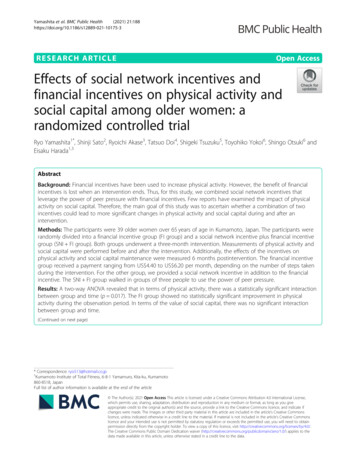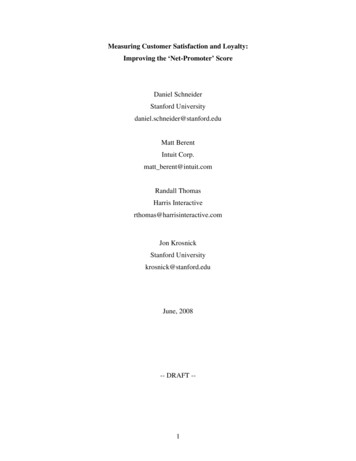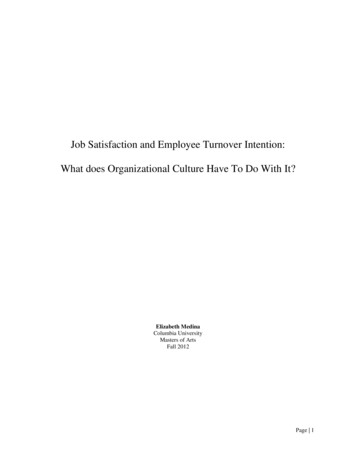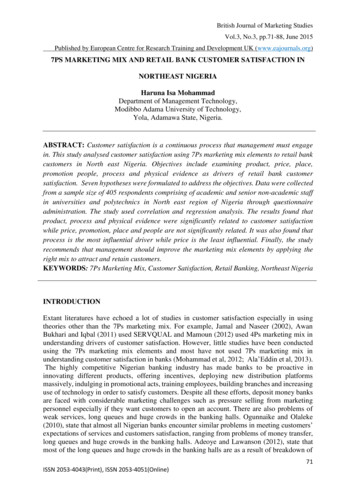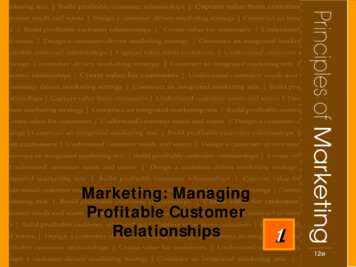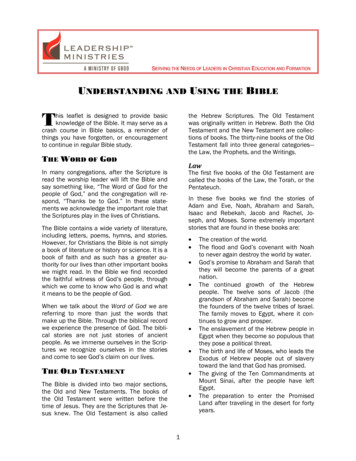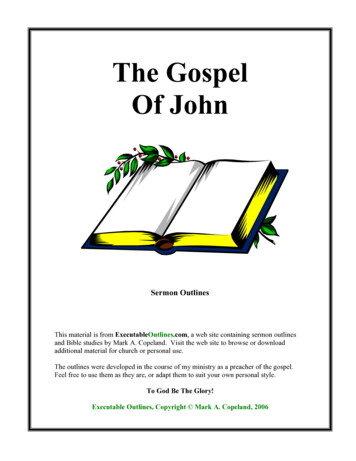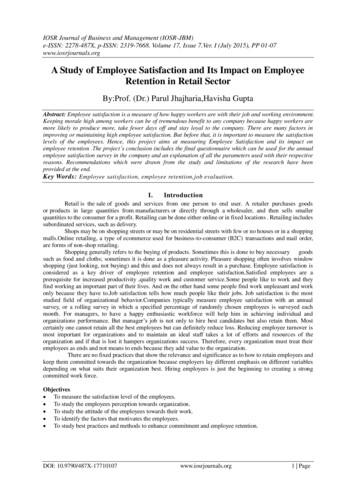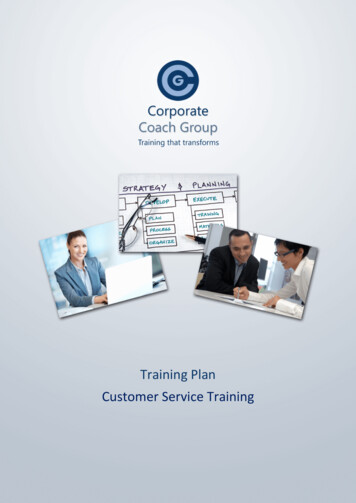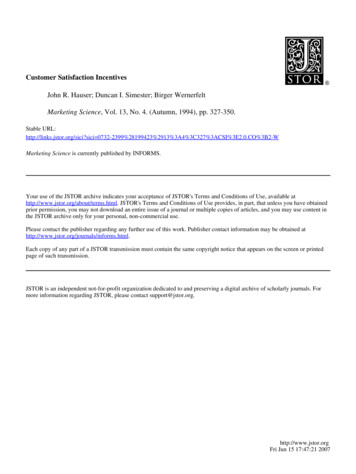
Transcription
Customer Satisfaction IncentivesJohn R. Hauser; Duncan I. Simester; Birger WernerfeltMarketing Science, Vol. 13, No. 4. (Autumn, 1994), pp. 327-350.Stable URL:http://links.jstor.org/sici?sici B2-WMarketing Science is currently published by INFORMS.Your use of the JSTOR archive indicates your acceptance of JSTOR's Terms and Conditions of Use, available athttp://www.jstor.org/about/terms.html. JSTOR's Terms and Conditions of Use provides, in part, that unless you have obtainedprior permission, you may not download an entire issue of a journal or multiple copies of articles, and you may use content inthe JSTOR archive only for your personal, non-commercial use.Please contact the publisher regarding any further use of this work. Publisher contact information may be obtained athttp://www.jstor.org/journals/informs.html.Each copy of any part of a JSTOR transmission must contain the same copyright notice that appears on the screen or printedpage of such transmission.JSTOR is an independent not-for-profit organization dedicated to and preserving a digital archive of scholarly journals. Formore information regarding JSTOR, please contact support@jstor.org.http://www.jstor.orgFri Jun 15 17:47:21 2007
MARKETING SCIENCEVol. 13. No. 4. Fall 1994Printed in L'.SA.CUSTOMER SATISFACTION INCENTIVESJOHN R. HAUSER, DUNCAN I. SIMESTER, A N D BIRGER WERNERFELTMassachusetts Institute of TechnologyUniversity of ChicagoMassachusetts Institute of TechnologyCustomer satisfaction incentive schemes are increasingly common in a variety of industries.We offer explanations as to how and when incenting employees on customer satisfaction is profitableand offer several recommendations for improving upon current practice. Faced with employeegroups (including managers) who may have shorter time horizons than the firm, such systemsenable a firm to use customer reaction to monitor implicitly how employees allocate effort betweenthe short and long terms. These systems can be used to encourage employees to make tradeoffsthat are in the best interests of the firm.We derive optimal reward systems for an equilibrium in which the firm maximizes profits,employees maximize their expected utility, and customers choose purchase quantities based oninitial reputations, employee efforts (both ephemeral and enduring), and price. The formal modelshows how the reliance placed on customer satisfaction in an incentive scheme should dependupon the precision with which customer satisfaction is measured and the extent to which employeesfocus on the short term. Recommendations for improving upon current practice include: measurecustomers, former customers, and potential customers; measure satisfaction with competitors'products; disaggregate satisfaction to reflect better the performance of employee groups; and,when different customer segments have different switching costs or they vary in the precisionwith which their satisfaction can be measured, then measure the segments separately and assigndifferent weights in the incentive plan.Throughout the paper we interpret the formal results based on our experience with actual firmsand the current literature. We close with a brief discussion of on-going research at field sites.(Competitive Strategy; Measurement; Customer Satisfaction; Incentives)Total Quality, because ofits focus on benchmarking customer and consumer satisfaction, is basicallyan insurance policy,for sustaining competitive advantage over the long term.-Edwin Artzt, Chairman and CEO ofProcter & GambleW e want to give the best customer service uf'any company in the world. . . . T o maintain ourreputalion for e.wcellent service, we long ago established high standardsfor the selection of salesmenand customer engineers.-From Thomas J . U'atson, Sr.'s (founder of I B M ) business doctrine'1. IntroductionMany American corporations include customer satisfaction or quality in their employeemotivation systems. In some cases, the rewards are psychological-management believesIThe Artzt quote is from Bemowski ( 1992). The Watson quote is from Watson, Jr. ( 1963, pp. 29, 30)3270732-23991941 1304/0327 01.25Copynght C 1994. The lnstltute of Management SclencesIOperations Research Society of Amenca
328JOHN R. HAUSER, DUNCAN I. SIMESTER, AND BIRGER WERNERFELTthat if employees know that customers are satisfied then these employees themselves willbe more satisfied and will work more effectively. In some cases, the rewards are implicit.Management believes that, in the long-run, a satisfied customer is an asset of the firmand that this asset makes the firm more profitable. Management communicates this beliefto the employees together with the implication that if the firm is more profitable, theemployees will remain employed and, perhaps, earn higher wages.In other cases, employee compensation is tied directly to customer satisfaction orquality measures. Ernst & Young and the American Quality foundation ( 1992) reporta dramatic increase in the percent of U.S., Japanese, German, and Canadian firms forwhich quality is the most important criterion for senior management compensation(90% increase over the last three years with projections that quality will be the primarycriterion in the majority of firms by 1995). Phillips et al. ( 1990) observe that both GTEand Montgomery Ward compensate management on customer satisfaction and qualitymeasurements. Mercer ( 1992, p. 1 1 ) reports that 76% of the electric and gas utilitycompanies have specific objectives for employees that include customer satisfaction targetsand that customer satisfaction incentive compensation schemes are most common inthe 25 largest companies. In our own discussions with Fortune 500 firms in both themanufacturing and service sectors, we have found that top management and middlemanagement are extremely interested in the effects that customer satisfaction measureshave upon profitability. Many are struggling to design profitable customer satisfactionbased management and/or compensation programs.Why all the attention? How does incorporating measures of customer satisfaction intoemployee incentive systems increase profitability? This paper offers potential explanationsas to how and when incenting employees on customer satisfaction can be profitable andsuggests several improvements upon current practice. The proposed explanations arethat incenting on customer satisfaction and sales overcomes short-term foci and providesmanagers and workers with incentives to make the short-term/long-term tradeoffs thatare best for the firm.We argue all employees (managers, product designers, service providers, productionworkers, etc.) allocate their effort between actions that influence current period sales andactions that influence sales in future periods. Unfortunately employees are generallymore focused on the short term than the firm would like. In response the firm can collectmeasures that we call "customer satisfaction." The measures we seek represent a (noisy)current period indicator of future profitability and a (noisy) measure of employee effortdirected towards the long-term. The greater the reliance on customer satisfaction in determining the size of bonuses, the more effort that employees will be expected to allocatetowards improving profit in the long term. Furthermore, to the extent that firms areunable to determine precisely their employees' effort levels (or tradeoffs), customer satisfaction provides a means to encourage profitable tradeoffs without the firm explicitlymeasuring employee effort.We begin with a mathematical model of customer, employee, and firm behavior inan environment in which each actor's actions are affected by the decisions of the otheractors. The model is based on our experience in developing customer satisfaction programs, interviews with practitioners in both manufacturing and service firms (includingmany Fortune 500 firms), interviews with market-research suppliers, and a review ofthe strategy, quality, marketing, and R&D literatures. We derive the model and characterize the optimal incentive schemes, expected (optimal) employee response, customerbehavior and the sales, prices, and profits of the firm. We then use the model to understandwhat influences the measurement and reward system and how we can improve uponexisting systems. The results have both descriptive and normative implications-we explain how firms may profit from measuring customer satisfaction and suggest severalimprovements upon current practice.
CUSTOMER SATISFACTION INCENTIVES2. Relationship with the LiteratureWe draw from the strategy, quality, marketing, and R&D literature focussing on shorttermism and customer satisfaction measures.In the strategy literature many papers have postulated that (American) corporationshave too much of a short-term focus. Managers and workers focus on short-term salesand profit at the expense of long-term profit, discounting future earnings at a higher ratethan is optimal for the firm. Indeed this problem is the subject of much popular writing.For example, Wollner ( 1992) argues, "Consumer shouts for better-quality cars wereignored as prices continued to rise . . . this was an effective short-term strategy withdisastrous long-term consequences." The Council on Competitiveness recently sponsoreda special report on this issue (Porter 1992). The report offers many explanations for thisshort-term behavior including labor market imperfections (Becker 1962, Grout 1984),take-over threats (Stein 1988), asymmetric information (Myers 1989, Stein 1989), andcommitment problems ( Weitzman 1980).To counter short-termism and to align employee incentives with those of the firm,companies have adopted a number of sophisticated incentive systems. Employees receivebonuses based on stock options, on stock price, on market share, on new customers, onnew products, and on other more subjective criteria. However, some systems suffer fromsevere free-riding problems. For example, while a CEO's actions might have a noticeableimpact on stock price, the actions of a single telephone-service representative will benegligible. Presumably, the more directly an employee's actions affect a performancemeasure, the more responsive employees will be to feedback and incentives based on themeasure.Many papers in the marketing and total-quality-management literatures have focusedon the measurement of customer satisfaction. The literature is extensive and diverse.Some papers focus on developing and testing more precise measurement scales whileothers use these scales and focus on the link from satisfaction (or quality) to future sales,purchase intentions, retention, loyalty, and other surrogates for revenue. Others test intervening variables, explore multiple linkages, and refine the conceptualization of satisfaction in order to develop a causal understanding of satisfaction formation, often inconjunction with behavioral explanations such as expectation-disconfirmation, equity,norms of comparison, and value-prompt disparity. The literature has also seen a normativefocus with the development of service-quality measurement systems and barometers thatseek to become indicators of firms' (or national economies') performance. In marketingand in the related discipline of total quality management many have argued that satisfaction should be a strategic focus of the firm.For the reader who wishes to explore these literatures we recommend Anderson andSullivan ( 1993), Bearden and Tee1 ( 1983), Bolton and Drew ( 1991a, b ) , Boulding,Staelin, Kalra, and Zeithaml ( 1993), Churchill and Surprenant ( 1982), Cronin andTaylor ( 1992), Deming ( 1986, p. 5 ) , Fornell ( 1992), Fornell, Ryan, and Westbrook( 1990), Fornell and Wernerfelt ( 1988 ), Fornell and Westbrook ( 1984), Gale ( 1992),Hayes ( 1992), Kordupleski, Rust, and Zahorik ( 1993), LaBarbera and Mazursky ( 1983),Oliver ( 1980), Oliver and DeSarbo ( 1988), Oliver and Swan ( 1989), Parasuraman,Zeithaml, and Berry ( 1988), Rust and Zahorik ( 199 1 ), Tse and Wilton ( 1988), Westbrook ( 1980a, b ) , Yi ( 1990), and Zeithaml, Parasuraman, and Berry ( 1990).Of course, customer satisfaction measurement is not without its critics. For example,Goodman et al. ( 1992) argue that customer satisfaction surveys are ineffective if theyare not tied to customer behavior. For recent critical reviews see Cronin and Taylor(1992) and Yi (1990).Naturally, such a diverse literature differs in its definition of customer satisfaction. Forexample, some researchers use transaction-specific or brand-specific measures while othersuse measures that indicate an overall customer evaluation of all experiences including
330JOHN R. HAUSER, DUNCAN I. SIMESTER, AND BIRGER WERNERFELTtransactions, product use, and service received. Furthermore, some limit satisfaction, bydefinition, to those products or services that the customer experiences while others broadenthe concept to include customers' perceptions of the satisfaction they would have receivedhad they experienced a competitor's product or service. Many in the literature are carefulto distinguish satisfaction (post-consumption experience) from quality ( a characteristicof the product or service) and from value ( a notion of quality net of price). For ourpurposes we do not define satisfaction explicitly. Instead we define it implicitly (Equations2 and 3 ) as a measure that indicates the long-term impact of those actions employeestake to influence tomorrow's sales. We recognize that the measure may not be perfectand that other intervening variables, exogenous to the model, such as expectations, normsof comparison, and equity, might or might not influence measured satisfaction. Thisallows us to focus on the managerial use of customer satisfaction measures and allowsus to formulate a theory that is consistent with a broad range of the behavioral andmeasurement literatures. The better the measure, the more powerful it will be as anincentive. However, we are careful to formulate a theory that models noise explicitly sothat we might explore the impact of imprecision in the measures.We build upon the following implicit (and sometimes explicit) premises that pervadethe literature:customer satisfaction is a multi-period issue-a firm (or its employees) takes actionstoday that affect purchasing behavior in the future;customer satisfaction measures are an indicator of future profit potential (moresatisfied customers will buy more, buy more often, buy at a higher price, and/orcommunicate their satisfaction to others).Based on these premises we explore the beliefs that can be found in the literature andwe examine proposals to improve upon current practice. Some of these beliefs are:customer satisfaction measures provide a better management tool if the measuresare more precise;employees who take or influence actions which affect customer satisfaction shouldbe given feedback and/or incentives to guide their actions; anda well-designed customer satisfaction system enhances profits.We now formulate a model that incorporates these premises and examines these beliefs.3. A Model of Firm, Employee, and Customer BehaviorTo incorporate the multiperiod premise we abstract to a two-period framework wherethe first period represents "today" and the second period represents the future impact,"tomorrow." The second period need not be of the same duration as "today." We needonly that today's actions affect the future in some discounted manner, that is, some oftoday's employee actions affect customer utility today and some affect customer utilitytomorrow. We focus on a focal firm keeping competition implicit.Yesterday and Today: Customer ResponseWe assume that customers arrive to the market continuously, thus all of the followingdiscussions of a "customer" refer to the rate of arrival in the interval dc. This is foranalytical convenience only. For ease of exposition, we present the definitions in theform of discrete customers.We assume that the firm has been in the market long enough to develop a goodwillreputation for quality, g. This reputation includes designed-in quality and customerservice characteristics such as a reputation for excellent technical support. Customersvary in their needs and their perceptions of the products, thus the potential reputation,gc, that any given customer ( c ) perceives in period 1 is equal to the average reputation,g, plus heterogeneity "error," PIC.That is, gc g PI,. For simplicity we assume that
CUSTOMER SATISFACTION INCENTIVES33 1the perceptual variations are independent across periods and customers and are normallydistributed with zero mean and positive variance.Following the total quality management literature, we focus on a group of employeesthat takes actions together and is rewarded together. For simplicity we assume that thegroup is motivated properly such that there are no free-riding problems within the group.We focus on the efforts (decisions and actions) of the employee group. (In the finalsection of the paper we examine characteristics of customer satisfaction measures thatmight reduce free-riding.)Some of the effects of that effort are ephemeral-the effort helps to make the sale butdoes not add to the firm's reputation for quality. For example, high-pressure sales tactics,attempts to serve many customers at once and attempts to sell unnecessary add-onsmight be such efforts. We call the component of effort that has short-term impact ephemeral effort (Bennett 1990), and we designate that effort (for customer c) by a,. Othercomponents of employee efforts have enduring effects. These efforts do not affect the saletoday but add to the customers' satisfaction and hence the firm's reputation for "quality."For example, post-purchase explanations of how best to use a product, support on installation, or recommendations on how to maintain the product over its lifetime all haveenduring effects. We call such components of effort enduring effort and designate them(for customer c) by b,. In practice, some employee efforts have components that areboth ephemeral and enduring, while some ephemeral actions may actually decrease theenduring reputation of a brand. The employee group need not separate efforts into theirephemeral and enduring components, and the firm need not measure these components.We need only that any given action (or decision) can, in principle, be described as havingephemeral and/or enduring components and that the employee group must make tradeoffs between these components. The employee group decides upon actions; our definitionssimply help us trace the impact of those actions. A well-designed customer-satisfactionincentive system will motivate the employee group to choose actions such that the allocation of effort between a, and b, maximizes the firm's long-term profit.We interpret employee group broadly. For example, in one firm with which we areworking, the employee group consists of managers of telephone representatives; in anotherfirm the employee group is a specialized team that trains retailers on how to use thefirm's product to produce the best result for the end customer. Examples of employeegroups are interfunctional product-development teams, quality control circles (Lillrankand Kano 1989), sales groups, telephone-service representatives, flight attendants, orbrand-management teams.It is worth noting that a, and b, are incremental efforts above and beyond what theemployee group would do without incentives. In this way we focus on those efforts thatwould not occur in the absence of a reward system. The impact of standard efforts onsales are captured by the initial reputations of the firm; the employee group is rewardedfor these efforts by a base wage, U , for each period.The firm (endogenously) selects its price in the first period, pl , in order to maximizelong-term profits. Customers then evaluate the firm's reputation for quality, price, andthe ephemeral effort expended by the employee group when deciding how much topurchase.Let G I , be the quantity the focal firm sells to customer c in period 1 , then:2We choose the linear demand function in the belief that the qualitative results are unaffected by this choice.While a linear model allows negative sales for some prices. profit maximization prevents this. g, a , and p aremeasured in monetary units. There is a unity multiplier of quantity/ for the right-hand side of the equationin order to make equation ( I ) consistent in units. Although our focus is on customer satisfaction, we keepprices endogenous to ensure that the results are not eliminated by price movements.
332JOHN R. HAUSER, DUNCAN I. SIMESTER, AND BIRGER WERNERFELTTechnically, ( 1 ), coupled with the continuous time nature of the model, implies thatcumulative sales are given by a Brownian process with drift E[q,,] and variance a:,.Tomorrow:Customer ResponseTomorrow's reputation is a function of today's reputation and the enduring effortexpended by the employee group. For simplicity we model tomorrow's reputation as gb, 4,. The employee group chooses ephemeral and enduring efforts for the firstperiod. In reality, tomorrow will be like today, and the employee group will make bothtypes of efforts. To focus on the short-term vs. long-term tradeoffs, we take the secondperiod as an ending period with no effort. However, the firm does set a profit-maximizingprice, p 2 , in period 2. "Today" represents those periods in which the employee groupmust make tradeoffs between ephemeral and enduring efforts. In reality, the ending periodneed never actually occur, a firm might face a succession of periods, like "today," inwhich both ephemeral and enduring efforts occur. The ending period is the most parsimonious manner to examine rewards based on today's enduring effort.The customer utility function and response in period 2 is analogous to that in period1. The customer will purchase quantities: and cumulative sales will be a Brownian process with drift E[q2,]and variance a:,.The Firm's MeasuresIt is often too expensive or too difficult for the firm to observe the effort allocated byeach employee group to each customer. Even if the firm could do so, it might choosenot to because ( 1 ) such measures may be viewed as too intrusive or may be proscribedby law and ( 2 ) the employee group may have customer-specific knowledge that enablesit to make better allocation decisions (as long as the rewards are set appropriately).We assume the firm can measure sales volume and customer satisfaction. Total customer satisfaction is a measure over customers of the benefit they receive from enduringactions by the employee group. As defined above, a firm's total reputation for quality inperiod 2 depends both upon its initial reputation and the enduring efforts expended bythe employee group. Future sales are related to this measure, but depend upon othervariables as indicated by Equation 2. We recognize that customer satisfaction is measuredwith error. From the firm's perspective this error, Zs, is additive. We assume that theerror in aggregate satisfaction is normally distributed with variance a::rThe increasing, concave function, f ( ), recognizes explicitly that variables exogenousto the model (e.g., expectations, norms of comparison, equity) might intervene betweenemployee effort and the survey measure of customer satisfaction. Specifically, we allowf ( ) to have other arguments as long as the arguments do not vary by customer.Equation ( 3 ) is a simple conceptual model. However, for technical reasons3 we needto assume that employees observe both sales and satisfaction measures for one customer.'We need this technical assumption to avoid the "Mirrlees existence problem" (Mirrlees 1974. Shavell 1979,Innes 1990). An assumption of a normal distribution allows highly negative (but low probability) outcomes.With such negative outcomes the possibility exists to induce any employee behavior with very large fines forvery poor outcomes. If employees can observe outcomes as they go along, they can avoid such very large finesby modifying their behavior. An alternative approach would have been to bound the extent to which measuredsatisfaction can differ from employee expectations by truncat ngthe tail of the error distribution (although thiswould breach one of the assumptions guaranteeing the optimality of the linear contract).
CUSTOMER SATISFACTION INCENTIVES333c before moving on to the next customer. While at first glance this assumption mightseem extreme, all we really need is that the employee group is aware of how well theyare satisfying customers so that there is a reasonable limit to the disparity that can existbetween the expectations of the employee group and measured satisfaction at the end ofthe period:Note that we can relate (3') to ( 3 ) by recognizing that Zs S, Zscdc.Because period 2 is an ending period, there is no need in our model for a customersatisfaction measure in period 2. In practice, there are multiple intermediary periods(weeks, quarters, years) in which both sales quantities and customer satisfaction aremeasured and in which employees are rewarded on both measures. In our model theseintermediary periods are treated as if they were merged into period 1.The Reward SystemTo encourage employees to make the tradeoffs that are best for the firm, the firmrewards the employee group based upon the sales-quantity and customer-satisfactionmeasures. In period 1, the firm pays a reward of w, (q', , S). The functional form and theparameters of the function are chosen to maximize profit. In the ending period, period2, the firm rewards only measured sales quantity; it pays a reward of w2(g2).It is convenient to think of w, and w2 as monetary rewards; however, they need notbe. Any set of rewards that the employee group values and for which the firm must paywould be appropriate including trips to sales conferences, company picnics, and awardsbanquets (Feldman 1992). For example, 3M, located in a cold climate, rewards someemployees with a close, reserved parking spot. For simplicity we assume that the amountthat the firm pays is equal to the amount that the employee group receives. The employeesalso receive a fixed compensation as remuneration for the minimum effort expended inorder to retain employment. We address below whether such compensation affects thestructure of the rewards.The Employees' MotivationsIn deciding how to allocate ephemeral and enduring efforts the employees act in theirown best interests. For example, one electric utility rewarded its telephone-service operators on the number of calls answered per hour. In some instances they just selectedwaiting calls and hung up immediately. When the rewards were switched to percent oftime that the operator is on-line with a customer, some operators found it rewarding toplace customers on hold while taking allowed breaks. This does not make the employeesevil; rather it recognizes that the objectives ofthe firm and the objectives ofthe employeesare often not identical. The telephone operators simply optimized against the incentivesthat the system provided. It is the firm's responsibility to design an incentive system thatresults in consistency between the firm's and the employees' objectives so that, whenacting in their own best interests, the employees take actions that also benefit the firm(Deming 1986).Incremental effort is costly to employees and becomes more costly as total effort increases. To model this phenomenon we approximate the employee group's cost of effortusing a quadratic cost function. Ephemeral and enduring effort are measured on thesame scale-that is, employee costs are S [a: bfldc. In practice, deciding upon thescale with which to measure such efforts is an important decision.Short-termism implies that employees discount rewards in the second period morethan firms. There are a number of reasons why employees discount the future more.Any combination of these reasons is sufficient; all need not apply. In addition to those
334JOHN R. HAUSER, DUNCAN I. SIMESTER, A N D BIRGER WERNERFELTset forth in the Council-on-Competitiveness report, we offer the following: ( 1 ) The employees may not have a life-time employment contract, thus the employees know thatthere is some likelihood that they will not be around to collect the rewards. ( 2 ) Theemployees may serve customers well and the customers may come back to the firm, butthe employees may not get credit for those customers. For example, consider an employeeworking in a rest-stop McDonald's on the highway leading to Cape Cod. While it isimportant to the McDonald's Corporation that rest-stop customers are treated well, it isless important to the employee because repeat business is infrequent. ( 3 ) Employees mayfear that the firm will change the reward system in the ending period. Finally, ( 4 ) thefirm may have access to a capital market that allows it to borrow at a better rate thanemployees. To capture these effects we normalize the discount factor of the firm to 1.0and assign a positive discount factor of 6 1 to the employee group.The employee group must deal with uncertainty in how enduring efforts affect customersatisfaction and with uncertainty in sales volume "today" and "tomorrow." Because ofthis uncertainty we must model employee risk preference. We do so with a von NeumannMorgenstern utility function that exhibits constant absolute risk a e r s i o nSuch. functionshave proven to be good approximations in a variety of field . In terms of a rewardsystem, constant absolute risk aversion implies that the employees' reactions to w , andw2 do not depend upon the fixed salary.Putting all of these arguments together, the employees maximize incremental utility,U( ), given by equation 4 where r is the measure of risk-aversion:.Recall that the rewards based on sales quantity and customer satisfaction are aboveand beyond the base compensation for normal efforts in the two
MARKETING SCIENCE Vol. 13. No. 4. Fall 1994 Printed in L'.SA. CUSTOMER SATISFACTION INCENTIVES JOHN R. HAUSER, DUNCAN I. SIMESTER, AND BIRGER WERNERFELT Massachusetts Institute of Technology University of Chicago Massachusetts Institute of Technology Customer satisfaction in
